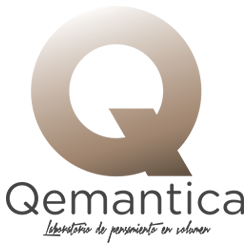
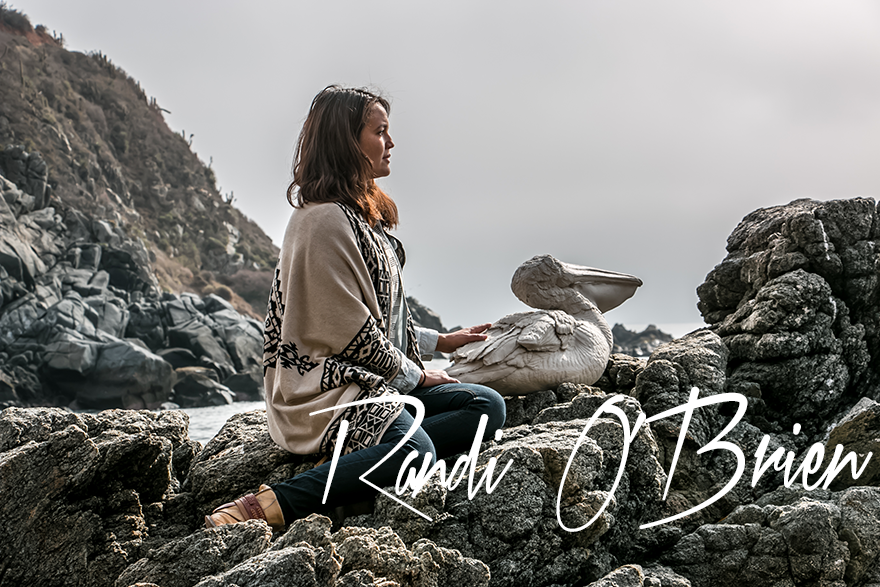
She has a combined intellectual life of extreme sports such as rafting, skiing and archery, and is also able to build her own kiln for firing her sculptures. She can be all that and more... Randi O'Brien access our proposal with a friendly smile and a cloth around her neck. The cloth holds in her arms one of her sculptures for safer transportation. It is a pelican that seem to come to life at any time. The idea is to reach the rocks at sea level. The photo shoot goes down where we came through vertiginous walkways and stairs resting on rocks frequented by birds and other marine animals. From there, at a height of about fifty meters, the facade of the Art Center Curaumilla, home to artists who come from around the world to exchange experiences and knowledge on ceramics, bordering the Pacific Ocean, in the region of Valparaiso is imposed. Ceramic art is how this American artist reflects her love of animals and nature. Romantic, bright-eyed, her sculptural and utilitarian works are a reflection of her person.
Tell me about yourself. You're an artist, mother, wife, teacher... How balance and time for everything accomplished?
I think of balance often. It’s easy to get consumed with being a professor and only focusing on my career within the university. It would be easy to only focus on my daughter’s growth; exposing her to all of the knowledge, activities, and pleasure I hope she experiences, as she becomes a young lady. I could definitely see myself only focusing on my art; sculpting and writing. I have so many ideas and not enough time to capture all of them in clay or in writing. But I could never be one or the other. I have so much passion swirling within me. And to be passionate, for me, means to see all of life’s offerings in as many different perspectives and contexts. To really know the things we love, we must see them from the perspective of a child, of a wife, of an artist, of a writer, and of a teacher. As for “time” and having enough time to accomplish my goals while staying balanced. I am completely comfortable with not having enough time. I yearn to create and document everything that swirls around in my imagination. Although, not being able to get to the art in the time I wanted is better. It is better because, it has given the idea time to mature within my mind. But I will say, I work very hard, using every moment to its fullest. For me there is no excuse to not live life to its fullest. Whether I am a mother, wife, artist, writer or professor every minuet counts.
How is your place in Montana, your environment, how do you like to be surrounded when working in ceramics? You have a ritual of inspiration in your workshop in Montana?
My studio space is humble. I have no electricity, no lights, no running water, it is an old falling apart garage that is leaning to the left like it wants to rest. While my studio space is minimal and sparse, when I am within the creative process, I am not in a physical space. I am in my mind. When I am creating, I have no need for special comforts, because I am only focused on the images and space of my mind. When I am within that creative process my mind and the space is quiet. My daughter and husband may be coming in and out of the garage, but its more like I filter out all of my surrounding and stay within my mind. There is a curious peace to working quietly in my mind. I do have a routine that I try to stick to if the day’s events allow. I wake up usually around 6:00 AM, and I write. Sometimes I’ll edit videos or photographs, I’ll grade papers for students in my Art History courses, but my goal is to write. Then at about 7:00 or 8:00 AM all hope for a routine is lost and I just go with the flow. In Montana we have a saying “Follow the Current” . It’s a rafting or river metaphor. The river only flows in one direction, if you are ever feeling lost or confused about were you should be, then you need to “Follow the Current”. If you follow the current you can only go in one direction, and that’s down stream. It’s a good metaphor for life. Follow the current, go with the flow… I try set little goals each day (make 40 cups, or sculpt one pheasant), but if an opportunity arises I jump on it like a life preserver and see where the current takes me.
What art detail and your everyday life is what most excites you?
The people who know me or see me on a daily basis, know that everything excites me. My greatest strength is my passion. I love to get lost in ideas and details of any kind. It doesn’t only have to be art. I love all interesting facts and stories. OH, especially stories! I could listen to people tell stories all day long and never get tired. You asked me earlier if I listen to music, I do, but I listen to Pod-Cast more. I love listening to people talk. It inspires me and it brings out images within my mind. I get very excited and passionate when stories are being shared.
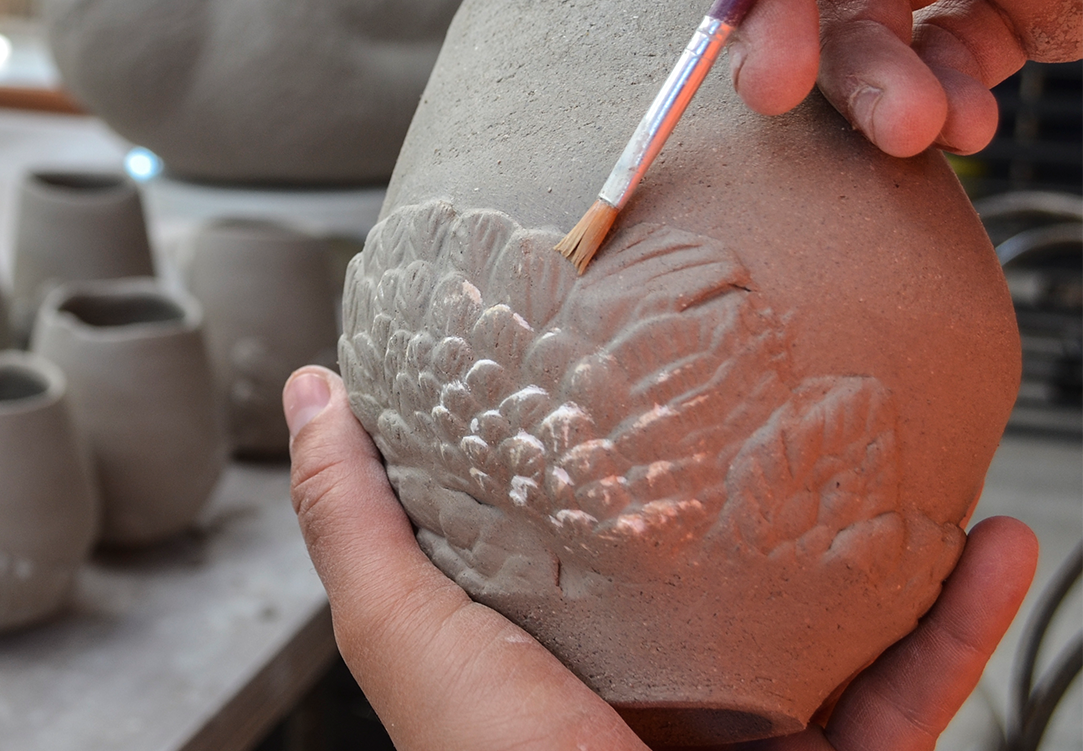
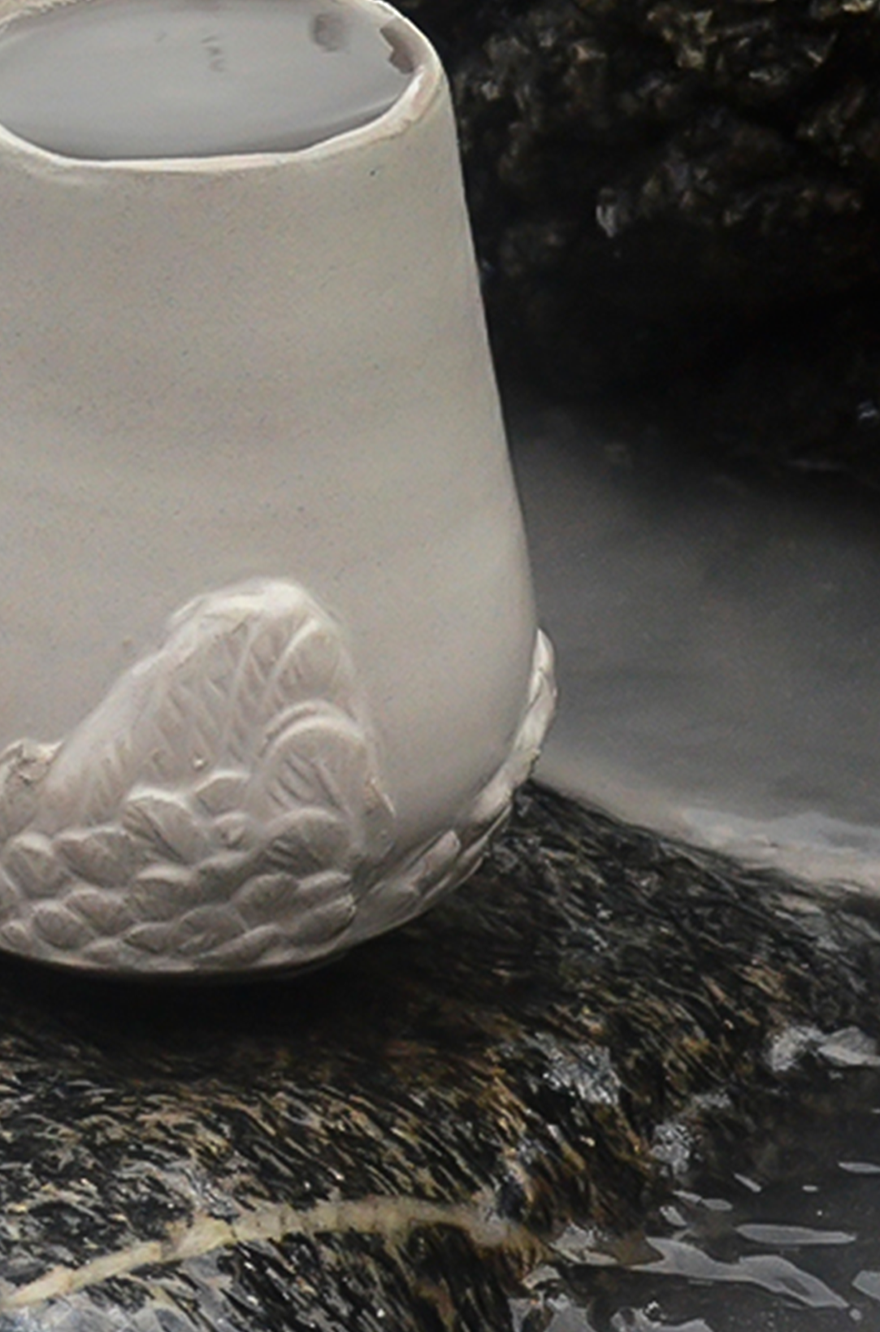


How do you create your works in the Art Center Curaumilla. Many pieces were born there using local clay. What motivated you to come here?
My work at Curaumill was a bit different that I traditionally work. I knew that I needed to work fast because I only had 30 days to capture my ideas about the life and death of pelicans. To make the most of my time I worked with plaster press molds. By using this technique I can focus on repetition and scale without havening to fight inconsistencies. I only use the molds when I need repetition as an element within my art and the idea. For the larger sculptural pieces I used clay purchased from Renaca. However, and one on my highlights at the residency was working with local clay that Victorina Gallegos (who works in the traditional style of Quinchamali), allowed me to use. One of my secret passions is local clay. In fact I’m working on a book about local clay in the United States. Victorina’s clay had so much character and personality. It is a deep and rich colored clay, much like dark chocolate or morning coffee. Local clay has allot to offer in terms of authenticity, culture, story telling (geographic and narrative story telling)… its just so romantic. My motivation to come here started simply and with practicality in mind. I needed a location that offered a working space within an environment that was wild. I needed the environment to manipulate my clay for the video / documentary. The dramatic stairs, expansive cliffs, and the ocean paired with the Curaumilla studios is the perfect combination for my ideas to develop. However, I think my decision to come to Curaumilla was deeper, more personal than practical. I think sometimes our lives move in directions beyond our control. Call it fate, call it destiny, call it what ever you choose. But now, in hind-sight, I see that I was given far more than a space to work. In reflection, I think our paths were meant to cross.
Tell me about your art conceptually, what stands out in your work, do you want to convey to the viewer and why you love animals to express your emotions. Make created birds, deer, other animals do you like and get close?
I choose to work with animals because of storytelling. In fables all of the primary characters are animals set within human predicaments. The animals are metaphors for the human experience. I grew up in a community rich with storytelling and that is something that is engrained within me. I want to share my experience. Through the use of fable the stories are more universal.
When and how is born your interest in ceramics? You use porcelain?
I took a ceramics course in college (2000), but I got serious with ceramics when I was pregnant with my daughter (2005-2006). I needed a hobby while my daughter was young and I felt ceramics would be an easy and inexpensive hobby. It wasn’t until I met David Hiltner (the Executive Director) at the Red Lodge Clay Center http://www.redlodgeclaycenter.com that I was taught that Ceramics is far more than a hobby. It is an art with many variations, forms, and disciplines. This is also the same year my daughter was born. Once I saw what professional ceramic artists were making, I decided to go to graduate school. I received an MFA (Master of Fine Art) in Ceramics and an MA (Masters of Art) in Art History. As for your question about porcelain; Yes I have and do use porcelain. For large sculpture, porcelain is not practical, but for my functional work and for the wood kiln I prefer porcelain.
Your sculptures seem to come alive and stand them details. You can talk about your technique?
I sculpt in an additive process. Which means that rather than removing clay to create details (like carving) I only add. I feel that the addition of clay makes the animals feel full, like they have just inhaled. My mentor, Julia Galloway, once spoke of a historic lidded jar. She said it looked as though it had taken a deep breath and was holding it in. Her comments on historical pottery moved me and influence the way I look at forms. I want my forms, both functional and sculptural, to feel full, like they are breathing. Beyond sculpting in the additive format, I also add individual press molds to create texture. Each of the large feathers is an individual piece of clay that is added onto of the animal form. The pelicans can have over 200 little additions of feathers added to them. This addition gives them texture and another layer of depth to the surface. While this process is excellent for texture, it is difficult to keep the layers from cracking. To prevent cracking, I hand blend each of the feathers into one another. By blending with a paintbrush the texture becomes seamless and strong. It’s a rather tedious process.
What was Randi girl? What is your best childhood memory that relates to the art?
As a girl I preferred the outdoors. I think it is because my father was an avid outdoorsman, and my mother has always had the best gardens. I spent allot of time with my parents. We were often outdoors working with our hands and exploring the mountains. As a young lady, age 13 to 21, I was a rafting guide, ski instructor, and competitive archer. My favorite childhood memory is still a tradition that we keep today.
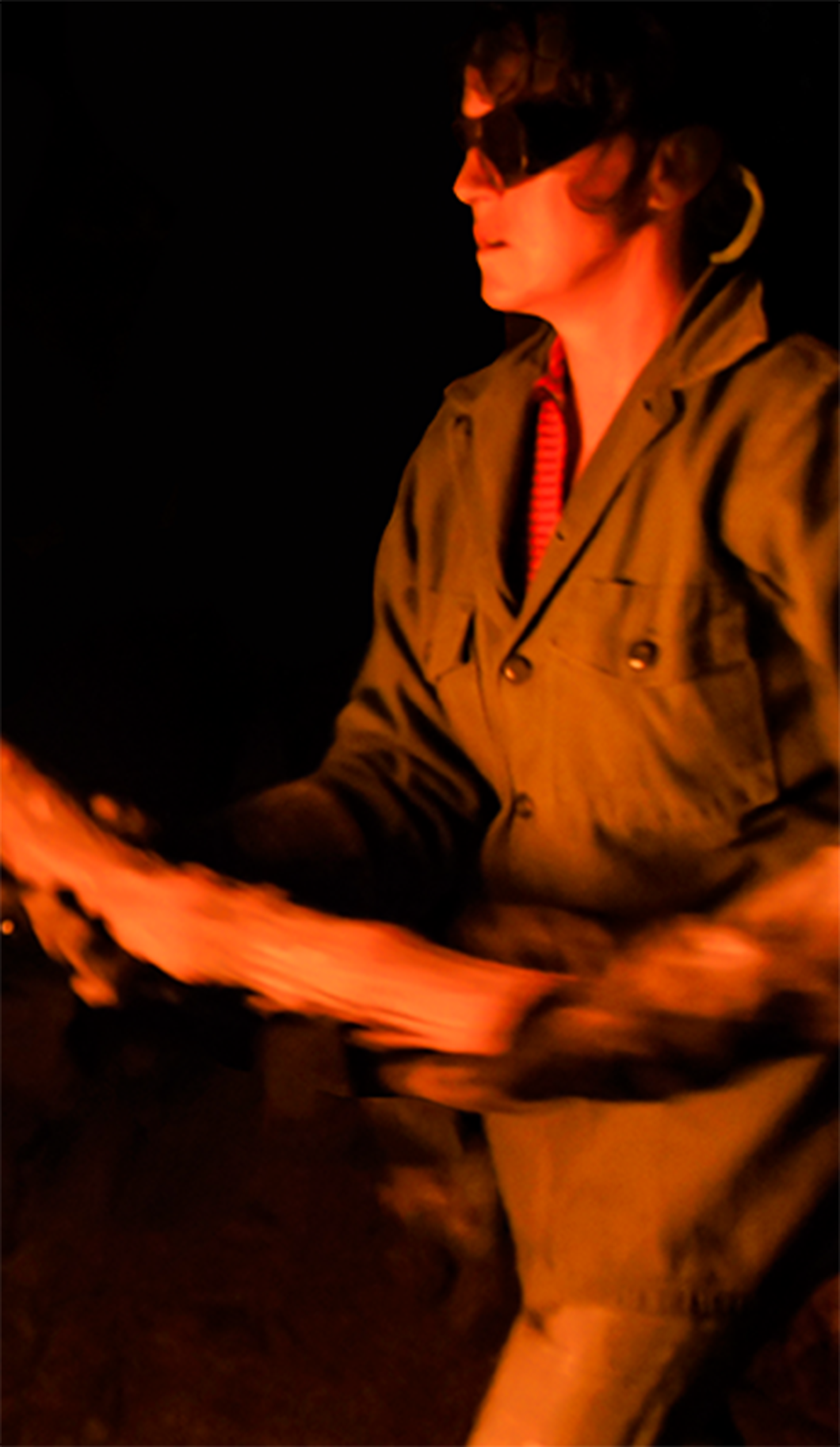


Every holiday my family would have a coloring competition; nothing fancy; cheap crayons and cheap holiday coloring book. We would all sit down and try to decorate and color the picture better than each other. For Easter it is an egg coloring competition. It is so much fun. All of my family members have such a unique style of coloring. As silly as it sounds, my family gets very competitive about it. If we are apart for the holidays we all send photos of our coloring pages and usually my mom is the judge. My mom still saves the pages we colored.
What is your relationship with animals and nature in general. What outdoor activities to excel and you like more?
In 2013 I was offered a career in New York as head of an Art History department. When we arrived to New York, it was beautiful, and an excellent adventure. But nature in New York is different. The trees are all perfectly planted in a row; the spacing is exact. I started to notice, as time passed, that I wasn’t very happy there. The career was perfect, the people are amazing, but I felt it was that lack of “wild” in the natural surroundings that made me uncomfortable. I tell this story because it is the first time that I realized how important the wild nature is to me. I’ve been blessed to live in the Rocky Mountains all of my life and I never knew any different. But when I left the mountains for New York, it became clear that I needed to find wild and raw nature to feel whole again. A walk in a public park is fine, or a day-trip to the national parks is fun, but I thrive in a setting with rivers, lakes, mountains, and the plains at my doorstep. Montana is one of the few states that offers all of that to its residents. Skiing, rafting, fishing, dirt biking, 4x4’ing, walking, listening, I just want to be in a place that is wild and raw.
Is it true that you like archery?
Yes, I was a competitive archer. I won 5 or 6 Colorado State Championships, and I set 4 or 5 State Records. I went to nationals and placed 8th. Archery was an incredibly big part of my child hood. I attribute my current focus and passion to my training as an archer. As a child I spent allot of time training with my father. He helped me to quietly focus and controlling my body and mind to find that perfect shot. In many ways being an artist and being an archer are similar. It takes allot of focus, desire, and training.
What do you think hunting animals?
People have very extreme ideas on both sides of this debate. For me, I firmly believe in conservation. Conservation can come in all forms. There is the obvious conservation of endangered species, but to conserver other highly populated species it is necessary to hunt. In Montana we have allot of mammals (wolves, bear, deer, elk, moose). If the wolves are allowed to continue growing in numbers they will over take an entire area and kill too many of the other species like, elk, deer, and moose. In this case to find a sustainable balance among the species it is necessary to hunt the wolves. In other areas of Montana there are no predatory animals. The elk and deer become over populated, can starve to death, and even suffer from disease. This type of overpopulation strains the land and the land cannot produce adequate food to keep the elk and deer alive. In this case it is necessary to hunt to ensure the animal population stays at a healthy and sustainable number. In the Rocky Mountains (Colorado, Wyoming, Idaho, and Montana) our government agencies (Fish, Wildlife & Parks - FWP) do an amazing job of wildlife management. FWP identifies sustainable populations and regulates hunting though licenses. I personally hunt and fish and believe in the conservation efforts of both non-hunter and hunters. Hunting should be a conversation about balance, not extremes.
What do you think of abstract art? In pottery it is easier to be abstract?
Abstraction is beautiful when it is used with intention. Sometimes people use abstraction as an excuse for laziness. This type of work is insignificant. But artists who have made intentional decisions and are using abstraction to highlight the qualities of material or form; this is the type of abstraction I enjoy. I personally don’t work with abstraction in my own art, but I still enjoy it as a visual art form.
Sometimes it's frustrating and sacrifice make pottery for some artists? For you too?
With all careers and passions there are frustrations and sacrifices. I don’t waste too much time on complaining about the difficulties. Well thats not entirely true, I do complain to my husband, but he is the only one who I would openly complain to. If it is difficult, or frustrating then I work to find way to make it more efficient and successful. Maybe that means going to back to school to study more, maybe that means I need to develop a new technique to make the sculpture survive a firing. But I don’t waste time being upset about it, I just fix it and keep moving forward. Sacrifice is not an easy problem to solve. When I am in a situation that I see a sacrifice needs to be made, I focus more on perseverance. If you can preserver through difficult times, then I think the gains from persevering outweigh the loss of sacrifice.
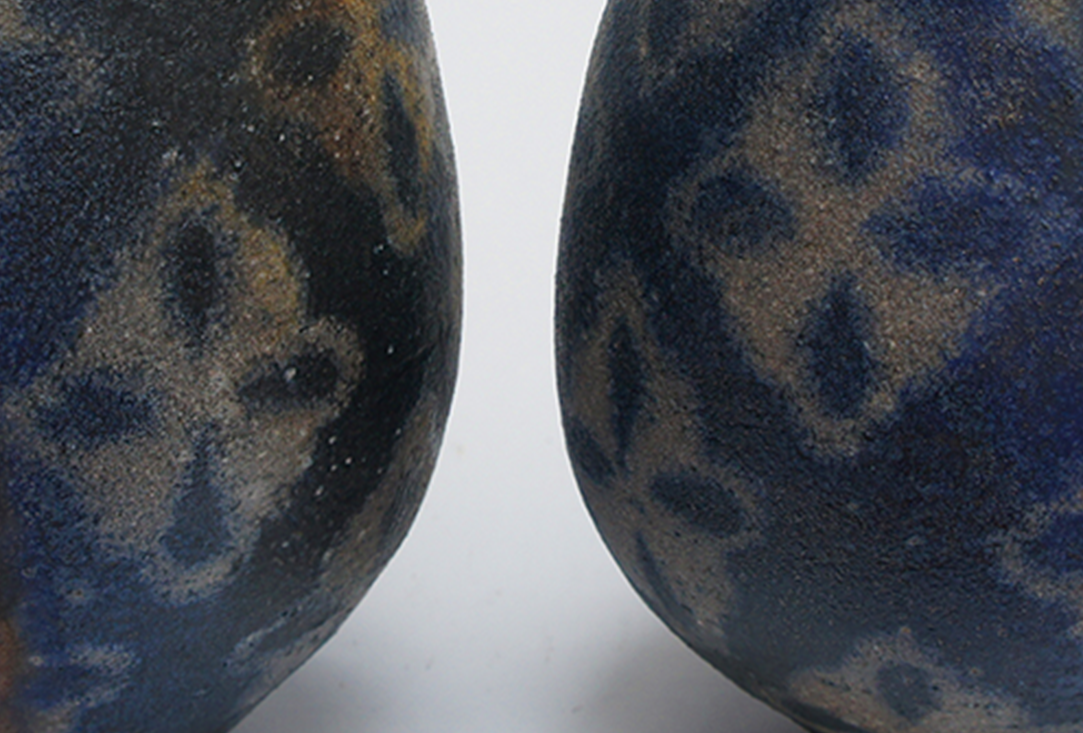
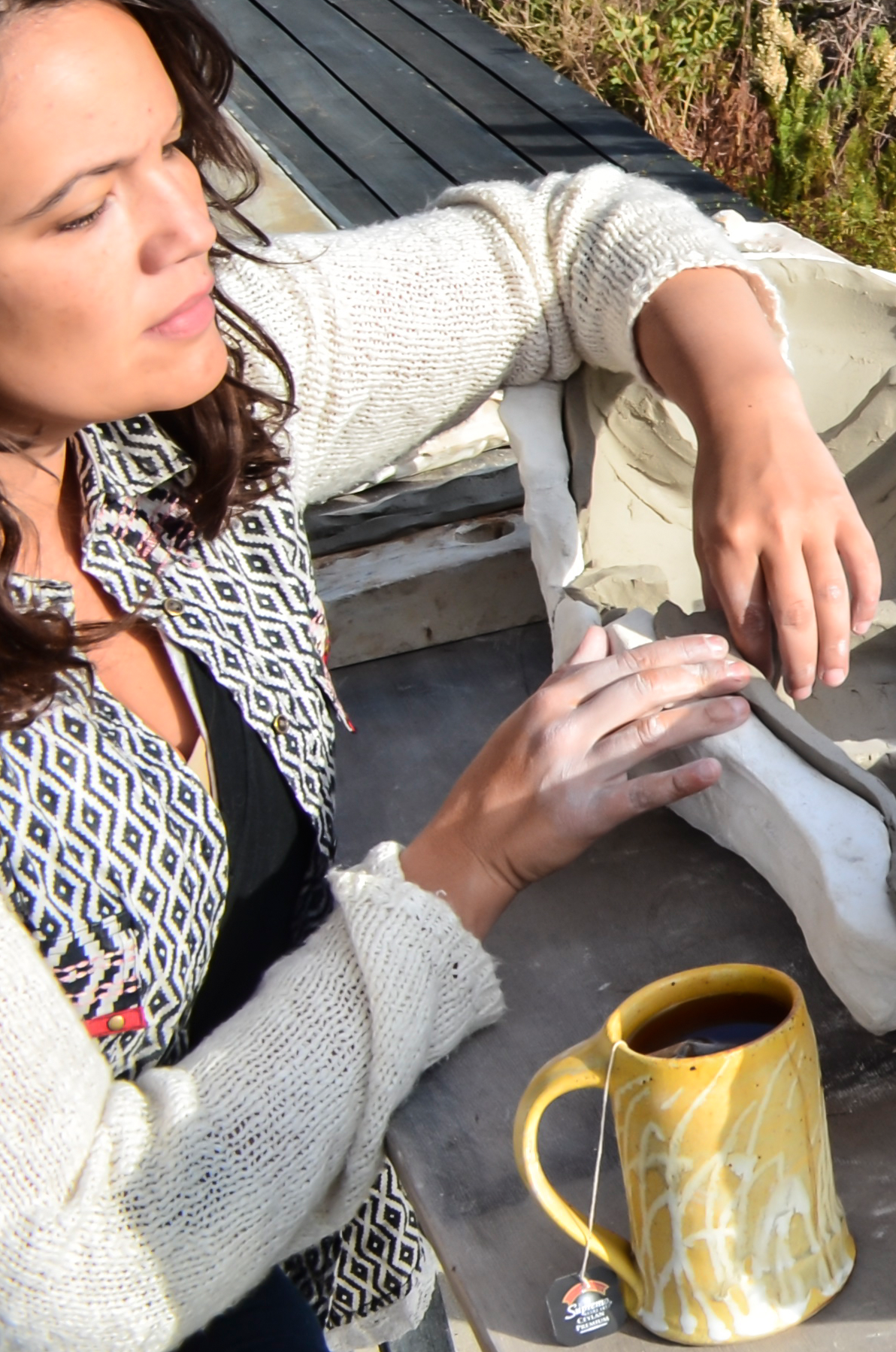

Who is your biggest influence on art and contemporary ceramics?
This question is really hard for me. I don’t place people in hierarchies of importance. Each artist and person is important to me for different reasons. It’s hard for me to choose who is most influential. If I had to pick one, maybe it would be Louise Nevelson. But even as I try to pick one, I’m thinking of others… My biggest influences in contemporary ceramics are my mentors. Julia Galloway, Trey Hill, Beth Lo, Josh Deweese, Dean Adams, David Hiltner… This list could go on and on. I am influence by their work ethic and approach to life more than I am by their specific techniques.
What can be achieved today in the world in which we live, that young people are more interested in art?
I have faith that young people will figure it out on their own. We spend so much time worrying, trying to fix our youth. But I don’t think our youth need to be fixed. They need an open door and the courage within themselves to stand for what they believe. Maybe its art, maybe its science, but I don’t want to be the person who manipulates their journey to achievement. I don’t want to assume that our youth “need” art, when maybe what they and our future really need is something completely different. As a professor and mom, I hope to give all of the youth I encounter courage; courage to think, to risk, and to fight if necessary. I think if we are going to think about how to help our youth, we need to focus on ensuring that they have a safe and healthy environment to grow and imagine in. I want our youth to be physically and intellectually safe. If they aren’t in this position of safety, then I want our youth to be able to identify how to make the necessary changes and sacrifice to find a place of intellectual and physical freedom. And maybe that comes in the form of changing politics, or changing our environment. I’m not in a position to make universal changes for our youth, but I am able to mentor. The bottom line is, that I want our youth to appreciate art, to appreciate cultural preservation, to appreciate tradition. But more importantly I want our youth to be critical thinkers. I want our youth to help identify what is important to them and there future.
I loved the title of your sculpture "Deposition" in Spanish means "Declaración". What is and what you want to express?
I’m always trying to tell a story. In my early work I was making frozen moment narratives. But now I’m moving more toward photography and video to tell the story of my clay and ceramic forms. I want my characters to act out beyond their frozen existence. By using short film and documenting the process my characters can come alive and have a greater life value. I really appreciate that you see a connection between fables and my work. That is how I imagine the work in my mind and I hope my audience sees this traditional story telling connection with a contemporary style. With each sculpture, I try to express new emotions or new predicaments. I try to tell new stories with each work of art. Ultimately the stories are of human struggles; life, death, entrapment, joy, greed, virtue, and yearning
Are you very strict with your work, what do you do if a sculpture is not as you expected? True, breaking prefer?
It depends on the situation. Sometimes a glaze will be a different color or drip in a manner that is unexpected. Sometimes my ideas change as I’m sculpting, and I will completely change the form. I think these types of scenarios are apart of the creative process and they happen often. However, if my sculpture has a structural crack, or my pottery has a glaze imperfection that makes the work not safe for food, then I feel these types of imperfection are unacceptable for sales. Art is expensive, and I don’t want my patrons to feel that they have been lied to. I want people who buy my work to feel confident in my integrity as a craftsman. If the work has structural or imperfections that can cause harm to my supporters, then I will destroy the work. If I didn’t destroy the work, then I have no idea what will come of the pieces after they have left my hands. Twenty, thirty, or a hundred years from now, someone may come upon my work, if this happen I want that person to be inspired by the skill, the care, and the details of my craftsmanship. I don’t want to represent myself now or in the future with sloppy or lazy work.
Tell me about the pelicans left on the wet rocks and the sea.
The video, which I shot about the pelicans at the ocean, was a conceptual art piece. It is an exploration of fragility and destruction versus strength and longevity. Many people who encounter ceramics only view it as a final object; a ceramic cup and ceramic sculpture. The piece is vitrified, which means CLAY has been converted into CERAMIC. But few people (other than the artist or maker) get to experience CLAY. Clay is an intimate material to work with. It is incredibly fragile, vulnerable, and impressionable. Ceramic on the other hand is quite the opposite. Ceramics is strong, permanent, and steadfast. The pelicans at the ocean explore this disparity between one material that has to forms: CLAY & CERAMIC. This work explores a bird that also lives in a realm of disparity: The Pelican. Did you know pelicans will die in the same place they nest? In some nesting grounds you many find eggs and hatchlings resting upon the bones and feathers of past birds. Ultimately, the ocean will destroy the clay pelicans. As the ocean dissolves (or the ceramic term is “slake”) the clay pelican, within the pelican resides a ceramic cup. The ceramic cup is impervious to the oceans destructive forces. It is a dialogue between life and death, and between fragility and permanence. The final piece will be documented in a short video. The video will show the process of carrying the pelicans down the stairs, will document my concept and thoughts on clay vs. ceramics, and will document the three pelicans destruction through stop-motion video.
Text and photos: Lila Vera and courtesy of the artist. http://www.randiobrien.com Thanks to: Pelusa Rosenthal and Andrés Honorato. www.centrodeartecuraumilla.cl


